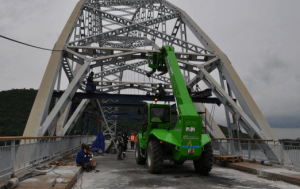Rehabilitation of Adomi Bridge nears completion
 Rehabilitation works on the Adomi Bridge at Atimpku in the Eastern Region, which started last year, is progressing steadily, and expected to be completed in November, one month later than the scheduled date.
Rehabilitation works on the Adomi Bridge at Atimpku in the Eastern Region, which started last year, is progressing steadily, and expected to be completed in November, one month later than the scheduled date.
Engineers working on the project say the work is 76 per cent complete, and is about 80 per cent operating within its contract sum of 12.9 million Euros.
Dr Paul Herrmann, the Project Manager told members of the Parliamentary Select Committee on Roads and Highways, who visited the project site at Atimpoku on Wednesday that time extension was granted to Bilfinger MCE, the Austrian construction firm working on the project, to provide for eventual necessary repair works on the arch.
“The new handing over date is 30th November 2015,” Dr Herrmann said.
He said the erection of the Toll Booth close to the Adomi Bridge has been called and rather proposed to be sited about 1.23 kilomtres near Juapong.
He stated among the challenges the projects was facing bothered on issues on tax exemption on overseas container consignments, delay in arrival of containers, and that it was not possible any more to adequately schedule time for supplies.
There are also slow custom processes, and electricity outages are worsening the situation.
Mr Michael Coffie Boampong, Chairman of the Select Committee, and MP for Bia West, suggested to the contractor and the engineer to channel their request to the Ministry of Roads and Highways, to facilitate their tax issues through the Ministry of Finance.
Mr Kwabena Owusu Aduomi, the Ranking Member on the Committee, stressed regular maintenance of the bridge to get its full life span of 100 when the rehabilitation works are completed.
The Adomi Bridge spans the Volta River, and connects the Volta and parts of the Eastern regions to other parts of the country.
It was originally designed by Sir William Halcrow and partners and Freeman Fox and partners and built by Dorman Long Bridge Engineering Limited in 1957.
Following the closure of the bridge in March last year, drivers and passengers were faced with various problems in their bid to move to the Volta Region and some parts of the Eastern region, which is cut off from the rest of the country by the Volta River.
The repair works cover the replacement of the entire bridge deck of 23 sections. As at last month, 22 of them had been replaced. Each bridge deck, prefabricated in Austria, comes in five pieces, but they are welded together as one before it is launched.
Out of the 40 hanger cables holding the bridge to the arch, about 25 cables have been replaced. Each of the hanger cable comes in two pairs.
The new deck is of asphalt on steel instead of the old decks which was made of the much heavier concrete on steel.
The two walkways on each side of the bridge will however be made of concrete on steel as the new tollbooth will now be sited about 1.2 kilometres from the bridge on either side.
When completed, the bridge will now have an inspection platform fixed under the bridge. The platform which will work hydraulically can also be operated at sections to detect any defects that might develop on the bridge.
This feature is to avert the difficulty in detecting faults in the past. An improvised lift fabricated at the project site has been fixed on the bridge to enable artisans to move up the arch and work on the replacement of the hanger cables.
Source: GNA
